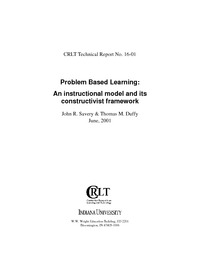Problem Based LearningAn instructional model and its constructivist framework
Publikationsdatum:
|
 |
 Diese Seite wurde seit 3 Jahren inhaltlich nicht mehr aktualisiert.
Unter Umständen ist sie nicht mehr aktuell.
Diese Seite wurde seit 3 Jahren inhaltlich nicht mehr aktualisiert.
Unter Umständen ist sie nicht mehr aktuell.
 Zusammenfassungen
Zusammenfassungen
It is said that there’s nothing so practical as good theory. It may also be said that there’s nothing so theoretically interesting as good practice. This is particularly true of efforts to relate constructivism as a theory of learning to the practice of instruction. Our goal in this paper is to provide a clear link between the theoretical principles of constructivism, the practice of instructional design, and the practice of teaching. We will begin with a basic characterization of constructivism identifying what we believe to be the central principles in learning and understanding. We will then identify and elaborate on eight instructional principles for the design of a constructivist learning environment. Finally, we will examine what we consider to be one of the best exemplars of a constructivist learning environment -- Problem Based Learning as described by Barrows (1985, 1986, 1992).
Von Thomas M. Duffy, John R. Savery  im Text Problem Based Learning (2001)
im Text Problem Based Learning (2001)  Dieser Text erwähnt ...
Dieser Text erwähnt ...
 Zitationsgraph
Zitationsgraph
 Zitationsgraph (Beta-Test mit vis.js)
Zitationsgraph (Beta-Test mit vis.js)
 Zeitleiste
Zeitleiste
 Volltext dieses Dokuments
Volltext dieses Dokuments
 |  Problem Based Learning: Artikel als Volltext ( Problem Based Learning: Artikel als Volltext ( : :  , 492 kByte; , 492 kByte;  : :  Link unterbrochen? Letzte Überprüfung: 2021-03-21 Letzte erfolgreiche Überprüfung: 2008-07-28) Link unterbrochen? Letzte Überprüfung: 2021-03-21 Letzte erfolgreiche Überprüfung: 2008-07-28) |
 Anderswo suchen
Anderswo suchen 
 Beat und dieser Text
Beat und dieser Text
Beat war Co-Leiter des ICT-Kompetenzzentrums TOP während er Dieser Text ins Biblionetz aufgenommen hat. Die bisher letzte Bearbeitung erfolgte während seiner Zeit am Institut für Medien und Schule. Beat besitzt kein physisches, aber ein digitales Exemplar. Eine digitale Version ist auf dem Internet verfügbar (s.o.). Es gibt bisher nur wenige Objekte im Biblionetz, die dieses Werk zitieren.
















 Biblionetz-History
Biblionetz-History